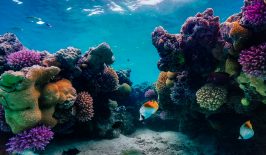In How is the Water, a video game set for release in 2022, players can become a dolphin and traverse the rolling seas. But the project, which has so far raised over 50,000EUR in Kickstarter funding, has been pitched as much more than just a fun underwater game.
The creators’ ambition is to accurately recreate parts of the world’s oceans and the complex marine ecosystems that are found there. As well as giving players a good time, How is the Water promises to teach people about a multitude of marine species, expand scientific knowledge about the ocean, and – hopefully – inspire passion for conversation.
To lure in gamers and conservationists alike, the game promises a range of fully immersive and highly novel features. The central gameplay is as a dolphin protecting its pod, or family, from a new and mysterious threat that prompts a treacherous voyage across the seas. Keen to capture the feeling of inhabiting another species’ body, the gamemakers aim to closely emulate the experience of being a dolphin: wearing a VR headset, players will be able to accelerate and decelerate with the bob of a head, in true delphinic fashion. Players will also have the opportunity to experience echolocation and electroreception, though it’s not yet clear exactly how.
In a demo livestream, which offers an inside look at the game’s early prototype, the dolphin protagonist can be seen roaming past corals and shoals, hunting for mackerel and chatting with manta rays. While the main gameplay is as a dolphin, other species are in the pipeline, including tiger sharks and whales. Species-specific challenges will help to give players a greater understanding of different animals and their behaviours.
The creators launched their first Kickstarter fundraising campaign for the game back in May, and in just one month the game reached its initial goal of 50,000EUR thanks to over 550 backers. It might seem like a meagre sum for such a bold and extensive production, but there’s sure to be further campaigns offering ever more complex features. Regular updates are posted on the Kickstarter page, including semi-regular livestreams.
The creators consider this game an “impact project”, and have partnered with conservation organisations such as WDC (Whale and Dolphin Conservation) and the Deutsche Meeresstiftung (German Ocean Foundation). The game has education and conservation at its heart, being co-created by marine and environmental scientist Ninja Mueller.
Real animal species will be “scanned” into the game in an effort to digitally preserve them, especially in the event of future extinction. The game aims to democratise access to the marine environment, allowing more people to experience life under the sea while bypassing the negative impact of human presence in actual marine ecosystems.
The profits from How is the Water will be reinvested in the project’s mission, as well as educational and scientific activities. Schools and other educational institutions will even receive free copies of the game, in a bid to inspire a passion for the ocean in future generations.
Luckily for non-hardcore gamers, it’s possible to play How is the Water without VR – the game will also be accessible on smartphone, tablet and PC. The game isn’t set for release until 2022, however, a PC-VR prototype can already be accessed by contacting the organisation.
The game is produced by Cyan Planet, an XR (extended reality) studio and social enterprise based in Germany. The organisation creates VR experiences with the aim of raising awareness for marine conservation. Their previous projects can be found on their website.





